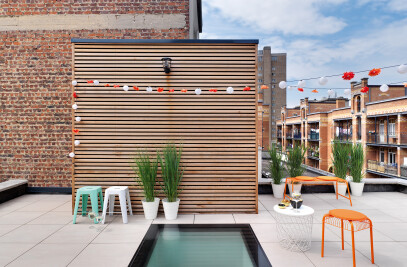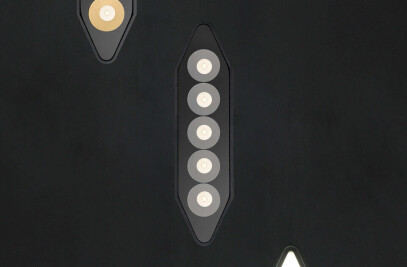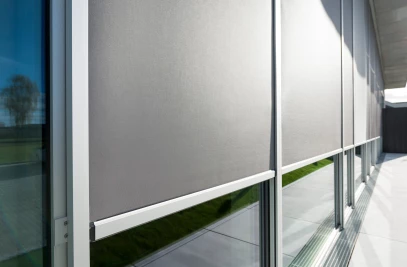Helsinki-based architectural studio Anttinen Oiva Architects has completed Katajanokan Laituri, a solid wood office and hotel building in Helsinki’s Katajanokka southern waterfront. This impressive mass timber building, the largest of its kind in Finland, demonstrates the Nordic nation’s continued achievements in the area of innovative and contemporary large-scale wood architecture.
Building in wood is a key measure in Finland’s bid to achieve carbon neutrality. In a country where forests cover almost 75 percent of the land mass, it makes sense to promote wood construction. The World Economic Forum notes: “Finland aims to become carbon neutral by 2035, putting it fourth in the world and ahead of every other country in Europe… [The country is] using legislation to promote increased use of wood in the construction sector” (Shine, 2023).
Located in the vicinity of Helsinki ́s famed Market Square, Katajanokan Laituri is the first new building to be built on the former industrial Katajanokka waterfront. It houses the head office of Finnish forestry company Stora Enso, a hotel with a cafe and restaurant, and office facilities. Spearheaded by the construction of Katajanokan Laituri, the waterfront area is undergoing a huge transformation into a cultural and leisure district and will be home to Helsinki’s new Museum of Architecture and Design. The building’s form maintains the uniform and neoclassical silhouette of the southern waterfront, while “the meandering shapes of its facade” help to break its scale.
From the outset, Katajanokan Laituri’s clients expressed their desire for a flexible and adaptable building with a long lifespan, constructed using renewable resources and materials.
“Katajanokan Laituri is the latest example of new-generation Finnish wood construction,” says Anttinen Oiva Architects. “The four-story building is made from Finnish and Swedish timber and uses pioneering architectural and manufacturing methods combined with traditional and sustainable materials.”
The building utilizes Stora Enso’s range of prefabricated massive wood products (walls, floors, roofs, stairs, beams and columns). The post and beam frame and facade structures are made from laminated veneer lumber (LVL) produced in Varkaus, Finland. The interior walls, lift and staircase shafts, and floor and roof structures, are made using cross-laminated timber (CLT) produced in Gruvön, Sweden. Katajanokan Laituri’s frame consists of 7,600-cubic-meters (268,392-cubic-feet) of spruce and around 2,500 wooden elements.
The building acts as the perfect carbon store, with carbon sequestered within its structure. “The wooden elements used in Katajanokan Laituri have captured 6,000 tonnes of carbon dioxide. The wood will store this carbon in the building for at least the next 100 years,” says Stora Enso.
Anttinen Oiva Architects developed a specific two-layer solution for the facade: the outer layer comprises glass, metal, and natural stone; behind this, wood is the main material. “A double skin was the best solution given the architecturally and technically challenging maritime context,” explains Selina Anttinen, architect and partner at Anttinen Oiva Architects. “The outer protective layer integrates with its stone-built surroundings and is made of glass with vertical white metal lamellas and natural stone. The building’s appearance transforms at different times of the day and fits the various scales and motifs of neighboring buildings from different historical eras.”
Katajanokan Laituri has four floors above ground, a green rooftop terrace (accessible to the public), and a basement with technical and parking facilities. Its street-level spaces connect to the surrounding city on both sides and include a large open hall, restaurant, cafe, and conference areas.
The building’s structural system and the design of its interior spaces ensure maximum flexibility and adaptability, promoting longevity. The use of exposed spruce structures combined with meticulous spruce and ash detailing showcases the beauty of natural wood. The striking hall at the center of the building, with its sculptural round skylight and massive circular wood bench, is a vivid wooden architectural feat.
The use of Viitasaari grey granite on the facades, paving, and interiors complements the natural wood and anchors the building within its urban context.
The building’s biophilic design connects its users to the natural environment, promoting well-being, improving productivity, and reducing stress levels.
Outdoor spaces are inspired by the beauty of Finland’s northern nature and include a birch grove in the courtyard and archipelago meadows on the rooftop.
Katajanokan Laituri sits in close proximity to the sea and therefore extensive flood protection measures were put into effect as part of the project. “As the first block redeveloped on the Katajanokka waterfront, this site spearheads the reactivation, reinforcement, and raising up of the entire embankment,” explains Anttinen Oiva Architects. “It paves the way for a future permanent reconstruction of the embankment as a continuous public space from the Market Square to the tip of Katajanokka.”
Gross floor area: 23,000 square meters (247,570 square feet)
Reference
Shine, I. (2023, June 1). Finland is on track to meet some of the world’s most ambitious carbon neutrality targets. This is how it has done it. World Economic Forum. https://www.weforum.org/agenda/2023/06/finland-carbon-neutral-2035-goals/










































































